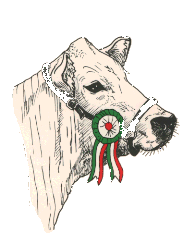

This ancient breed has been raised for over twenty-two centuries and is indigenous to Val di Chiana, the fertile plain in central Italy, located between the regions of Tuscany and Umbria, that gave this breed its name. It then spread throughout all the provinces in Central Italy and, following World War II, it also crossed the ocean into South America, Australia, Canada and the United States. The giant of the species, pure white and highly noble in its morphological perfection, Chianina has earned an international reputation thanks to a genetic heritage that is unique throughout the world. Its characteristics of somatic gigantism, rapid growth and early maturity are combined with enormous resistance to harsh environmental conditions and great ease of calving, all of which represent zootechnical factors essential to the production of beef that is commercially superior since it is lean and offers excellent nutritional characteristics. Put together, these characteristics have made Chianina one of the best beef cattle breeds in the world.
Work to improve this breed began towards the middle of the nineteenth century: the choice of breeders, based exclusively on morphological features, was aimed towards obtaining animals that could achieve the dual function of meat and work.
The selective approaches were then modified to obtain animals with shorter limbs, increased development in the length of the trunk and thus of the lumbodorsal region, and greater muscle development of the rump, thigh and buttocks.
In any case, the need to have animals that are increasingly more productive and that can satisfy market requirements has recently pushed selection towards a more modern type of animal, or in other words, towards an emphasis on the characteristics tied to beef production.
Using a modern and effective instrument like its Genetics Center, ANABIC has now initiated a selection plan for the Chianina breed that is based on the most advanced theories. The sires are selected through performance tests and selection criteria include growth capacity, muscle development and estimates of high slaughter and carcass yield, while respecting the traits typical of this breed.
The choice of females is made on the basis of morphological criteria and maternal capacity, or in other words the cow's ability to raise its young during the lactation phase.
As far as planned mating is concerned, the selection program also envisions using the best bulls, which have been tested in performance tests, and the best breeding cows, which have been indexed according to maternal capacity. Artificial insemination is used to the greatest possible extent.
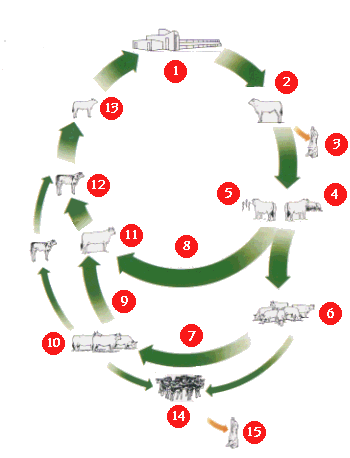 SELECTION GOALS AND SCHEME
SELECTION GOALS AND SCHEME
The selection scheme summarizes the activities that are carried out in order to ensure genetic improvement. These activities center on a genetic evaluation of the sires that are to be assigned to artificial insemination (5) on the basis of performance tests (1). Assessment and choice of breeding cows is based on maternal capacity and reproductive efficiency (7), while mating is aimed towards further accelerating genetic progress (8). Lastly, offspring are checked for traits that cannot be noted directly through performance tests (14).
Its harmonious proportions and precise shape lend it elegance and dignity. This type must immediately make an impression because of its imposing size, the length and height of the trunk without any traces of coarseness, and it can be appreciated for its small head size and fine-boned skeletal structure. It has an alert yet docile temperament and does not show any signs of nervousness or aggressiveness.
This breed is characterized by the high daily increases in live weight which, in young males, can even exceed 2 Kg/day, and by the weight of adult subjects. It is quite common to see bulls that weigh over 1600 Kg and cows weighing more than 1000 Kg.
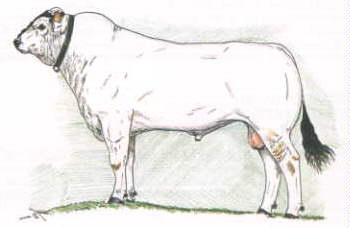
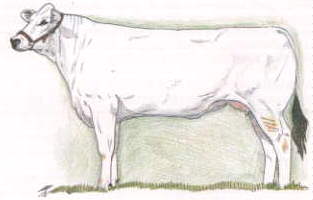
A basic breed trait, the mantle featuring white hairs set into on a pigmented skin is also the reason behind its well-known resistance to solar radiation. The presence of any gray shading, limited to the neck and shoulder area, never has any definite outlines and must not give the impression of intense coloring. Instead, it blends in harmoniously with the mantle. Its presence is often connected with the type of breeding system (open-pasture or semi-open-pasture).
The persistence of a reddish poll is tolerable when the animal presents exceptional morphological and functional characteristics. It is important to remember that this trait did not originate with previous forms of crossbreeding, but arise through the discontinuous expression of genes present in the genetic inheritance of this breed. Pigmentation is pronounced.
The fine quality of the dermas not only has a notable effect on the commercial value of the carcass, but it is also important in ensuring proper thermoregulation. The dewlap and the sheath are extremely light, the neck is furrowed by numerous vertical folds that show off how fine the skin is.
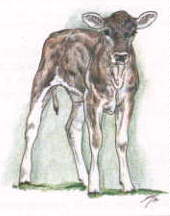
The shape and size of the cranium are important and should be assessed in relation to the overall size of the animal. The skull is extremely light and connected harmoniously to the neck, with straight profiles and taut skin that can reveal the fine sculpting of the craniofacial bones.
Well-developed masseters, broad and well-shaped muzzle. Pronounced expressiveness, lively and attentive black eyes. Broad ears with long fine hairs, set horizontally, quick to pick up sounds from the surrounding environment. The head is the expression of this breed and should be evaluated in this light.
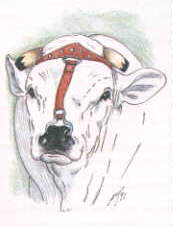
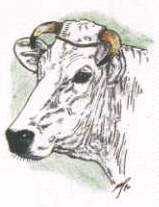
The neck is strong and muscular and full of fine cutaneous folds; connected harmoniously with the adjoining areas. Muscular and never slender in either males or females. The bulls also have a gibbus that highlights their masculinity even at an early age. The dewlap is light and never overly pronounced or loose.
The shoulder must be wide in order to constitute a broad base for the muscle attached to it and must be set closely to the trunk and thus without any relaxation of the muscles of the thoracic girdle. It should be well-directed, or that is, closely set to the chest and well-angled. In other words, it should form an angle that has a proper opening (115-120°) with respect to the humerus.
Even though the withers supply third-quality cuts, they must be broad and muscular and joined continuously to the back.
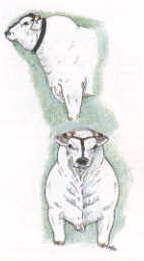
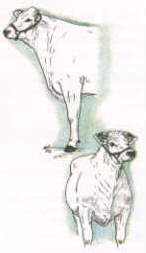
Due to the fundamental importance of the cuts of meat supplied by this area, which help determine carcass value, this area must present marked muscle development, demonstrating a "double convexity". This feature is determined mainly by the longissimus dorsi (the largest and longest even muscle on the body), which supplies cuts that are rich in muscle tissue but low on connective tissue (steaks).
In addition to the longissimus dorsi, this region includes other sublombar muscles that constitute noble cuts such as filet and sirloin. The loins must be extremely muscular, long and full, demonstrating the "double-convexity", also seen in the back, that is typical of specialized beef-cattle breeds. The lumbodorsal line must be straight and strong, denoting a suitable indication of bone structure.
Chest breadth is synonymous with thoracic cavity capacity and thus of proper function as far as the organs it contains are concerned. It must be muscular, sloping and convex.
The skeletal base of this area must ensure the development and function of the organs and body parts located in the thoracic cavity. The sides must be arched and covered well by the muscle layer. The thorax represents an important index of constitutional strength.
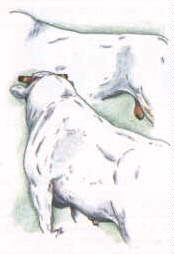
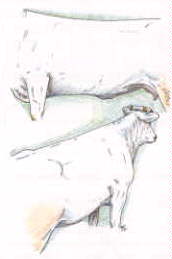
Although the abdomen is broad and ensures good ingestive capacity, it must be well supported. The lower line must be practically straight, a feature typical of beef cattle with high yields at slaughter. This is an indication of good muscle tone in this area.
The rump must be very broad and well-developed in both width and length. It should be very muscular since it supplies first-quality cuts. A broad rump also facilitates calving.
As opposed to the ideas held in the past, an ideal rump is not perfectly level but should be inclined slightly towards the pin bones, a position that also facilitates the elimination of waste fluids.
Special attention should also be paid to assessing the insertion point of the tail and the sacrum, a defect that is rather common in this breed.
Since this is the basis of the most important first-quality cuts, it is extremely important that these two areas express the development of muscle mass in a very evident way. Therefore, these parts must have a markedly convex profile.
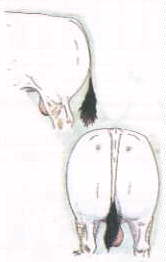
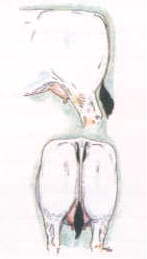
The forelegs must be perfectly perpendicular and must be set on strong solid hooves. The shin must show fine-boned features.
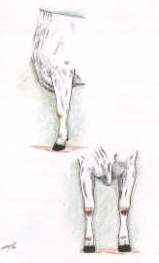
They carry out an extremely important role due to their determining influence on the animal's longevity. They must be strong and perfectly perpendicular, with lean hocks; there must not be any synovial effusion (flaws) and the tendons must be highly visible. The shin of the hind legs must also be fine-boned.
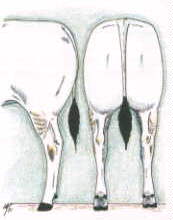
The foot is also particularly important in terms of the animal's longevity. It must be strong and have a very compact hoof, but above all, the heel must be high. The pastern must be strong, short and pointed in the right direction.
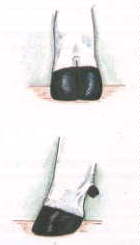
Even though this breed is not geared towards milk production, the cow must nevertheless be capable of raising a calf that will be heavy when weaned. Therefore, it is important that the cow produce a large amount of milk. Moreover, the shape of the udder and teats must not give rise to frequent pathological or traumatic problems.
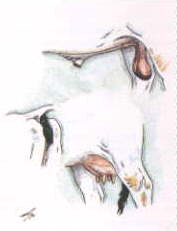
|
Height of withers
|
||||
|
Class
|
Heifers18-24 Months
|
Cows 1st calving
|
Multiparae
|
Males 12 Months
|
|
1
|
<132 | <141 | <142 | <137 |
|
2
|
132-138 | 141-147 | 142-149 | 137-141 |
|
3
|
139-145 | 148-154 | 150-157 | 142-146 |
|
4
|
146-152 | 155-161 | 158-165 | 147-151 |
|
5
|
>151 | >161 | >165 | >151 |
|
Length of Trunk
|
||||
|
Class
|
Heifers18-24 Months
|
Cows 1st calving
|
Multiparae
|
Males 12 Months
|
|
1
|
<144 | <154 | <158 | <146 |
|
2
|
144-151 | 154-160 | 158-166 | 146-151 |
|
3
|
152-159 | 161-167 | 167-175 | 152-157 |
|
4
|
160-167 | 168-174 | 176-184 | 158-163 |
|
5
|
>167 | >174 | >184 | >163 |
|
Height of Thorax
|
||||
|
Class
|
Heifers18-24 Months
|
Cows 1st calving
|
Multiparae
|
Males 12 Months
|
|
1
|
<61 | <67 | <68 | <63 |
|
2
|
61-64 | 67-71 | 68-73 | 63-65 |
|
3
|
65-68 | 72-76 | 74-79 | 66-68 |
|
4
|
69-72 | 77-81 | 80-85 | 69-71 |
|
5
|
>72 | >81 | >85 | >71 |
|
Width of Thorax
|
||||
|
Class
|
Heifers18-24 Months
|
Cows 1st calving
|
Multiparae
|
Males 12 Months
|
|
1
|
<39 | <37 | <37 | <41 |
|
2
|
39-44 | 37-42 | 37-44 | 41-43 |
|
3
|
45-50 | 43-48 | 45-52 | 44-46 |
|
4
|
51-56 | 49-54 | 53-60 | 47-49 |
|
5
|
>56 | >54 | >60 | >49 |
|
Width of Lips
|
||||
|
Class
|
Heifers18-24 Months
|
Cows 1st calving
|
Multiparae
|
Males 12 Months
|
|
1
|
<41 | <47 | <51 | <43 |
|
2
|
41-45 | 47-51 | 51-55 | 43-44 |
|
3
|
46-50 | 52-56 | 56-60 | 45-46 |
|
4
|
51-55 | 57-61 | 61-65 | 47-48 |
|
5
|
>55 | >61 | >65 | >48 |
|
Width of Pins
|
||||
|
Class
|
Heifers18-24 Months
|
Cows 1st calving
|
Multiparae
|
Males 12 Months
|
|
1
|
<29 | <30 | <32 | <30 |
|
2
|
29-32 | 30-34 | 32-36 | 30-31 |
|
3
|
33-36 | 35-39 | 37-41 | 32-33 |
|
4
|
37-40 | 40-44 | 42-46 | 34-35 |
|
5
|
>40 | >44 | >46 | >35 |
|
Length of Rump
|
||||
|
Class
|
Heifers18-24 Months
|
Cows 1st calving
|
Multiparae
|
Males 12 Months
|
|
1
|
<44 | <49 | <49 | <50 |
|
2
|
44-47 | 49-52 | 49-53 | 50-51 |
|
3
|
48-51 | 53-56 | 54-58 | 52-53 |
|
4
|
52-55 | 57-60 | 59-63 | 54-55 |
|
5
|
55> | 60> | 63> | 55> |